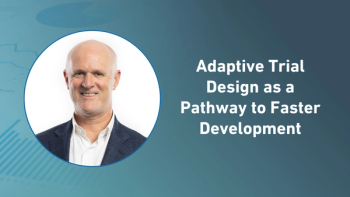
Rare Diseases: Meeting the Unique Challenges of Orphan Drug Development
Poor understanding of the natural history of the proposed indication due to few observational studies studying disease progression, heterogeneous patient populations with variable phenotypes and clinical courses, geographic dispersion of patients and investigators, regulatory uncertainties, and lack of prior clinical studies to establish a template for study execution, can all prove challenging in creating a pharmaceutical development program for the treatment of a rare disease.
While individually rare, orphan diseases are actually collectively common, with an estimated 350 million sufferers worldwide. Since the introduction of the US Orphan Drug Act more than 30 years ago, the number of orphan designations has skyrocketed and experts are predicting worldwide sales of these drugs will reach $176 billion by the end of 20201. With the cost of developing orphan drugs comparatively less than non-orphan products, appreciable regulatory support for innovative program design, and with the possibility of demonstrating significant intellectual property value, interest and investment in orphan disease development programs has been explosive.
Creating a pharmaceutical development program for the treatment of a rare disease can, however, prove to be a monumental task. Poor understanding of the natural history of the proposed indication due to few observational studies studying disease progression, heterogeneous patient populations with variable phenotypes and clinical courses, geographic dispersion of patients and investigators, regulatory uncertainties, and lack of prior clinical studies to establish a template for study execution, can all prove challenging. In addition, small patient populations isolated in a few tertiary care centers go against traditional methods of study operation. With at least 7,000 rare diseases, each exhibiting diverse symptomatology, the key differentiator for CRO engagement frequently is expertise in problem solving, and passion for clinical development rather than disease-specific experience.
The Importance of the Patient
In an orphan drug trial, clinical management of individual patients can be difficult. Understanding the burden of disease and managing patient and family experience within a study is key. Patients with a rare disease frequently arrive at a diagnosis through a lengthy process of evaluations and may be experiencing a reduced quality of life and, in some cases, limited life expectancy. In rare disease trials, the need to recruit and retain patients while adhering to exceptional standards of care influences every decision. The protocol must account for the vulnerability of the patient population and address ethical considerations, particularly if the study design mandates discontinuation of ongoing therapy considered essential for patient support. Eligibility criteria always influence the number of available subjects, and if artificially constrained, reduce the likelihood of establishing a clinical trials database from which evidence of efficacy and safety can be extrapolated to a larger network of representative patients with the same disorder.
It is well-documented that rare diseases exert a substantial physical, emotional, and financial impact on patients and loved ones. Many rare diseases are fatal in infancy or childhood â and children who do survive to adulthood face difficulties transitioning from pediatric to adolescent to adult care, and frequently the clinical presentation will evolve. Furthermore, treatment often involves multiple specialties such as neurology, gastroenterology, psychiatry, endocrinology, cardiology and physical therapy because clinically important comorbidities are common. Assuring care coordination in the context of an interventional study is important. CRO partners will be able to assist sponsors in considering all these factors when creating the study plan, obtaining input from key opinion leaders (KOLs) on diagnostics, outcome measures and care processes that can help inform trial design and study metrics.
Despite these challenging circumstances, patients with rare diseases and their caregivers are typically well-informed about their condition. Thanks to the wealth of information available via the internet and social media platforms, they have easy access to information regarding disease management and treatment options. They are also more engaged with not only their healthcare providers, but also with other patients with similar conditions, and use social media extensively as an exchange platform for emerging basic and clinical research data.
In order to enhance the clinical trial process for participants, as well as improve study outcomes, sponsors frequently utilize the experiences and knowledge of patients and caregivers in the process of trial design. By doing this, drug developers can gain valuable insight into experiences associated with a specific condition - after all, firsthand knowledge of what it is like to progress through site visits and procedures while managing an illness is not something that can come readily, or exclusively, from a professional point of view. This crucial input can then be used to develop 'patient-centric' trials that make participation as easy and informative as possible for the patient, while increasing efficiency and enhancing the sensitivity of study outcomes.
Unique Challenges
There are some fundamental differences between conducting trials for non-orphan drugs and those for orphan drugs, which present unique opportunities.
First, finding and activating feasible study sites and qualified investigators can be difficult. Selection involves identifying countries with a sufficient number of suitable study participants, then determining whether these patients are accessible, and finally, identifying centers of excellence with the therapeutic and operational capabilities to execute an observational or interventional trial requested. The nature of the indication emphasizes the importance of the medical, cultural and regulatory context as well as the standard of care and treatment pathways within each country of interest.
Smaller patient groups and, occasionally, a decreased likelihood of identifying and engaging patient advocacy groups, means identifying and locating participants can be extremely challenging, while retaining them for the full study duration is key particularly when modification in longer-term outcomes influence approval. If there is no patient advocacy group, general registries such as the Global Rare Disease Patient Registry and Data Repositorya, entities such as the National Organization for Rare Disorders and the European Organisation for Rare Diseases; as well as resources such as Orphanetb â are invaluable as a first step in an algorithm leading to site identification and selection.
Once sites are selected, site-by-site recruitment, retention analysis and planning and specialized outreach, must be undertaken. When studying an orphan disease, every single patient's participation is vitally important given limitations in patient availability, and the exceptional impact the data from a limited number of patients may have on program development. Engaging sites, investigators, and patients to confirm acceptance of the study design is vital. Proactively engaging all stakeholders can foster a collaborative approach that facilitates recruitment, retention and commercial value long-term.
To ensure high levels of participant retention, sponsors must make the patient experience as smooth as possible and where practical, reduce the burden on the patient and caregiver regarding both visit frequency, and visit intensity (the number and complexity of assessments at a site). For example, in-home nurse visits cognizant of the need for GCP compliance could be offered when patient mobility is a problem, and financial and logistical assistance should be provided to aid any travel and lodging requirements.
Pediatric Research
Approximately 50 percent of patients with rare diseases are children. Understandably, patient recruitment, retention and management can present more challenges with a younger demographic. Participants’ physical, intellectual, and emotional growth, developing attitudes and beliefs, as well as family dynamics, all have an influence on their participation. It is key to strike a careful balance between reducing risk and discomfort, and obtaining meaningful data. To support engagement and compliance, sponsors frequently consider age-appropriate communication, particularly during the assent and/or consent process, and ensure that disruptions to family life and school activities are minimized.
Additionally, a pediatric rare disease study might only enroll one to three patients per year, per site and therefore, creative and proactive site management planning is vital for those professionals and other support staff who will have responsibility for patient management. Mutually beneficial relationships include the establishment of a proactive publication strategy, opportunities for investigator sponsored investigations embedded into an overall program of clinical research, and assistance in the creation of physician and patient educational programs that would facilitate product adoption following approval.
An Evolving Regulatory Climate
Although orphan drugs typically follow the same regulatory approval path as non-orphan products, securing approval for the trial designs often required in rare-disease studies can provide an exciting opportunity for innovation. The introduction of the Orphan Drug Act of 1982 has provided considerable impetus and subsequently, there has been a significant rise in the number of orphan drugs being successfully brought to market, using a mosaic of different program designs.3 In fact, before the Act’s introduction there were just 38 approved orphan drugs, compared with more than 460 today2. Acknowledging its success, Japan and the European Union have since mirrored the US’ incentives and introduced comparable legislation, which offers tax credits, user fee waivers, and marketing exclusivity, to those developing drugs to treat rare diseases.
In August 2015, the FDA released an updated draft guidance which is intended to offer sponsors further support when tackling the common issues encountered in the development of orphan drugs4. While the issues addressed are also present in non-orphan drug development, the FDA highlights that many of the challenges are accentuated given the rarity of the disease and the gravity of the unmet clinical need, and therefore require special attention.
Interestingly, the guidance highlights the need for sponsors to gain greater biological, clinical, and epidemiological knowledge about the specific rare diseases under investigation, and suggests conducting natural history studies, through various forms of observational research in a companion development program. By conducting these studies - which look at the progression of a disease from initial symptoms, formal diagnosis, through various clinical endpoints, the FDA suggests that companies will be able to design more efficient drug development programs. Additionally, as these studies also provide information regarding healthcare utilization in representative patients under standard of care settings, the data influence decisions for formulary placement and levels of reimbursements.
For sponsors, working with scientific and regulatory professionals who have experience interacting with authorities can offer significant benefits to advancing programs. For example, because of the breadth and depth of experience in other orphan indications, they can offer support in mitigating limitations that may be present in non-clinical data, provide a rationale for the use of non-validated biomarkers that nevertheless are "fit for purpose" in early phase investigations, as well as recommend innovative trial designs for proof of principle studies.
Final Thought
All challenges considered, current market trends and industry predictions would suggest an increasing emphasis in considering unique genotypic and phenotypic information within a variety of larger indications under an umbrella of ‘personalized medicine’. An interest in developing either repurposed or novel products for orphan indications represents a natural extension of this activity. As a result, the number of drugs that are successfully brought to market for a variety of orphan indications is likely to rise. However, securing regulatory approval for the trial designs required in this area requires an exploration of innovation in study design, appreciation of evolving regulatory guidance, and incorporation of patient and family perspectives into the scope and detail of the drug development process. Additionally, successful commercialization efforts are predicated on demonstration of value during the course of clinical development, requiring different types of trials capable of evaluating changes in overall healthcare utilization following the introduction of innovative therapy; i.e., an effort which evaluates the impact of novel therapy on a ‘system of care’ in order to enable patient access. Given the unique technology represented by these products, educational programs for physicians and patients enhance informed adoption.
By working with strategic partners who have the expertise and experience in designing and delivering these trials, and the passion to address unmet clinical needs, sponsors can implement effective patient-centric trials which will meet the special demands of this underserved clinical population.
Michael F. Murphy M.D. PhD is Chief Medical and Scientific Officer at Worldwide Clinical Trials.
References
Sasinowski, FJ, Panico, EB, Valentine, JE: Quantum of Effectiveness Evidence in FDA’s Approval of Orphan Drugs-Update, July 2010 to June 2014 . Therapeutic Innovation & Regulatory Science September 2015 vol. 49 no. 5 680-697.
Registries & Organizations
a. Launched in 2012 by US National Institutes of Health Office of Rare Diseases Research.
b Orphanet, led by a consortium of 40 countries, is a reference portal for information on rare diseases and orphan drugs, for all audiences.
Newsletter
Stay current in clinical research with Applied Clinical Trials, providing expert insights, regulatory updates, and practical strategies for successful clinical trial design and execution.






.png)



.png)



.png)
.png)
